Motorcycle Investor mag
Subscribe to our free email news

Profile - Honda GL1500 Valkyrie series
(July 2020)
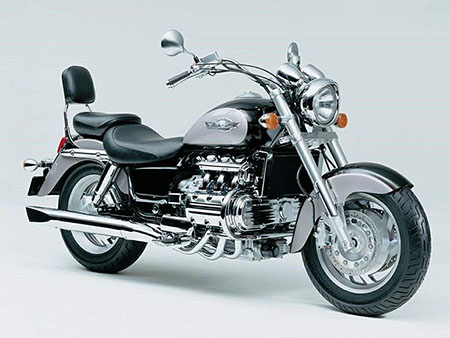
Ride of the Valkyries
by Guy 'Guido' Allen
Honda's flat six Valkyrie 1500
cruiser series of 1996-2003, essentially a stripped
back sibling to a Goldwing, was king of the
performance hill in that market sector for a long
time. Though now well and truly superseded it remains
a pretty decent ride.
When you talk collectible motorcycles to people, more often than not they’ll get a mental image of a naked classic, or a café racer style, or perhaps a full-on sports bike. Cruisers? Not so much. Sure there are old Harleys and Indians, but relatively modern stuff, say from the eighties onwards, rarely makes the cut. And a Japanese cruiser? Forget it!
I’m not so sure that will always remain the case. Over
time there have been a very small group of Nippon models
which have changed the way we think about metric cruisers.
One that springs to mind is Yamaha’s 1200 V-max, which
arguably lifted the benchmarks of the entire sector when
it was first introduced.

Another – and yes we’re sticking our proverbial necks out
here – is Honda’s 1500 Valkyrie. For my money it is the
best big two-up cruiser to come out of Japan over the
1990s. That’s a big statement, but bear with me on this.
One of the reasons it succeeded was it had two motorcycle
cultures behind it: American (if anyone understands
cruisers, it has to be them) and Japanese. You get the
ideas and overall inspiration from the first plus
rock-solid engineering and production standards from the
second. That’s a good combo.
Something else that makes the Valkyrie stand out is it was
built in the States, at Honda’s Marysville factory. Sadly,
that plant closed down in 2009, after a 30-year run.
Okay, let’s get back to the bike. The underlying concept
was a stripped-down or hot-rodded GL1500 Gold Wing.
Typically a Wing of the period would run twin carburettors
on its boxer six powerplant and produced around 75kW
(100hp).
The Valkyrie went for six carbs, which looked fantastic,
with three a side hanging out in the breeze. It also
scored different cams, screw and locknut valve lash
adjusters (in place of hydraulic) plus different ignition
tuning. Weirldly, and despite all the alterations, its
power and torque claims were similar to the 'Wing. This
was in contradiction to the riding experience, which was
far more lively.

To put those numbers in perspective, in 1996 when the
Valkyrie was introduced, your average stock big Harley was
producing more like 60 ponies. It meant the monster had a
surprising turn of speed and was one of the most powerful
cruisers on the market – Yamaha’s V-max would have been
head of the horsepower pack at that stage, even in detuned
form.
For once, someone produced a cruiser and didn’t feel
obliged to have forward foot controls, so you could ride
this thing like an admittedly huge ‘normal’ motorcycle.
Comfort was good, with decent suspension and good seating.
Straight line performance was excellent for this style of
motorcycle and the low-revving nature of the powerplant
meant if felt like it was never really stressed. Meanwhile
the more free-flowing exhausts (when compared to a Wing)
allowed you to hear at least some of the growl from the
six-pot powerplant.
For a big and heavy motorcycle, it actually steered and
handled pretty well.
Someone confident with heavy machinery could punt it along at a very respectable pace and achieve pretty decent point-to-point times. The only let-down by modern standards was the brakes were okay but not sensational. The twin-piston front calipers were borrowed from the CBR600 range and were adequate, but nowhere near as sharp as you might expect some 20-something years later.
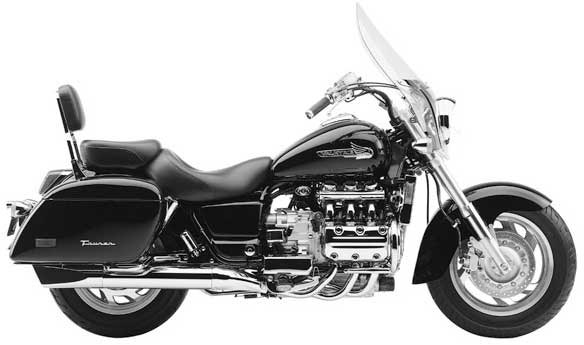
Three versions of the 1500 Valk were built: the standard
or GL1500C aka F6C (top of page), the Touring or GL1500T2
(above) and the Interstate or GL1500CF (below). The
touring was a standard with a big screen and hard panniers
added.

However the Interstate was significantly different to
either of the other two, with altered suspension rates,
modified seat, a much bigger fuel tank (over 7lt more),
subtly altered tuning for better midrange and the addition
of a big handlebar-mounted fairing, panniers, giant
topbox, AM/FM radio plus wiring for headsets, intercom and
CB radio.
I owned a Valkyrie Interstate for a few years and did a
lot of miles on it. It was easily the best tourer/cruiser
I’ve owned and selling it was probably a mistake. It was
fast, comfortable and utterly reliable. Build quality was
very good and the maintenance intervals surprisingly long.
Valve lash was scheduled every 20,000km while cam belts
were due every 160,000km. Fuel consumption was around the
mid-teens if you weren’t holding it flat, so this was not
an expensive motorcycle to run.
(Ed's note: since this feature was written, I've bought
another. See it here.)
They still pop up on the market, though low-milers are
thin on the ground. Big miles wouldn’t necessarily scare
me, so long as the maintenance had been done. I’d want a
good hard look at the condition of the chrome, as there is
a lot of it and refurbishing the cosmetics on one of these
things would be an expensive exercise. This is a bike I’d
want to eyeball before handing over the cash.
There’s little chance these bikes will become hugely valuable, but a good one should have done all the devaluation by now – the market is at rock bottom. Over the long term, a nice example should hold its value and might even keep up with inflation, if you look after it. More importantly, they’re still a pretty good ride and a very effective long distance machine.
Honda really went to town on these things with the styling and the bling. The big six hanging out of the frame is a highlight, while there are plenty of detail touches. For example, the Frenched tail-lights on the rear of the Interstate topbox are a work of art. It’s unlikely you’ll see anything quite like this generation Valk again – reason enough to consider grabbing one.
***

The 1800
In 2004 Honda released the NRX1800 Rune cruiser. As the
model designation suggests, it was built around the 1800
rather than the 1500 powerplant. Production numbers were
small (2600) and the prices were steep: over $25,000 in
the USA and closer to Au$50,000 here.
The numbers reflected a (nearly) cost-no-object styling and technical exercise that was as much about branding as it was motorcycles. Despite the gargantuan looks, they had a reputation for being surprisingly easy to ride. It was effectively a sign-off for the nameplate at the Marysville plant.
Honda's next-gen Valkyrie, launched in 2014 (below), was Japanese made and again ran a variant of the 1800 powerplant. It was now a little more conventional and affordable.
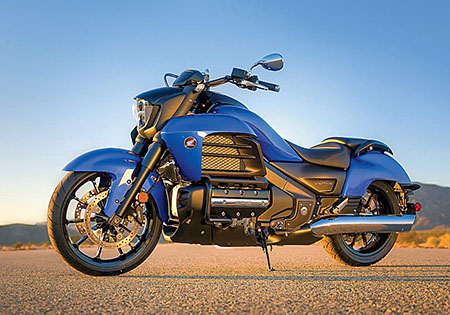
RATINGS
Good
Quick
Comfortable
Bulletproof
Not so good
Big to handle
Most have huge miles by now
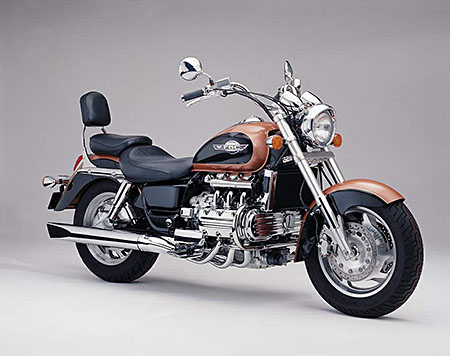
SPECS
Honda Valkyrie GL1500 (1996-2003)
ENGINE
TYPE: Liquid-cooled, two-valves-per-cylinder, boxer six
CAPACITY: 1520cc
BORE & STROKE: 71 x 64mm
COMPRESSION RATIO: 9.8:1
FUEL SYSTEM: 6 x 28mm CV carburettors
TRANSMISSION
TYPE: Five-speed, constant-mesh
FINAL DRIVE: Shaft
CHASSIS & RUNNING GEAR
FRAME TYPE: Steel loop
FRONT SUSPENSION: 45mm Showa, 130mm travel
REAR SUSPENSION: Showa twin shocks with preload
adjustment, 120mm travel
FRONT BRAKE: 296 discs with 2-piston calipers
REAR BRAKE: 316mm disc with 2-piston caliper
DIMENSIONS & CAPACITIES
DRY WEIGHT: 309kg standard, 352kg Interstate
SEAT HEIGHT: 730mm
WHEELBASE: 1690mm
FUEL CAPACITY: 20lt standard, 26lt Interstate
WHEELS & TYRES
FRONT: cast alloy 150/80-17 tyre
REAR: Cast alloy 180/70-16 tyre
PERFORMANCE
POWER: 75kW @ 6000rpm
TORQUE: 130Nm @ 5000rpm
OTHER STUFF
PRICE NEW:
$19,990 plus ORC - 1996 standard
$22,990 plus ORC - 1997 Touring
$26,990 plus ORC - 2000 Interstate
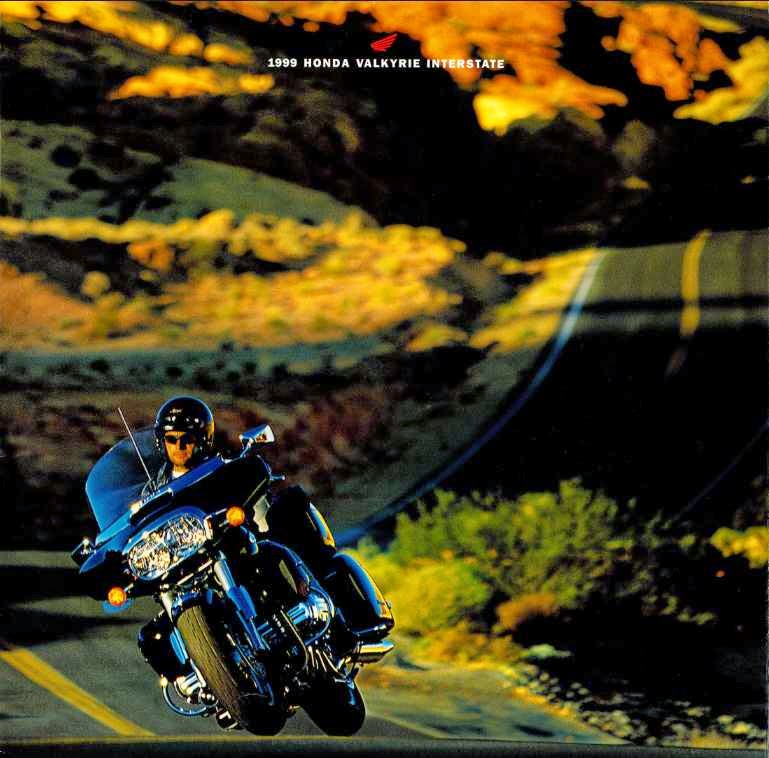
-------------------------------------------------
Produced by AllMoto abn 61 400 694 722
Privacy: we do not collect cookies or any other data.

Archives
Contact



